

10 Murderers Who Changed How We Investigate Murder. Forensics: The Anatomy of Crime review – the grisly evolution of swab justice. The other day, friends of ours were raided by the Metropolitan police, who confiscated computers and digital storage devices on suspicion of paedophile activity.

The couple had neglected to secure their modem with a password, but the police needed to make sure that the modem had indeed been “compromised”. After eight weeks, the computers came back with no evidence on them of child pornography. “It’s a horrible thing for you and your family to have gone through,” said the detective constable apologising for the unjust suspicion. A perfect stranger had apparently parked his car outside the family house and, using a smartphone, hacked into their Wi-Fi network. Increasingly, cyberspace is where we are judged by others and, on occasion, even destroyed. Lombroso’s systematic mug shots and fingerprints of presumed delinquents anticipated police identikit and photofit taxonomies, which crudely divide the human face into constituent parts (aquiline nose, pug nose, flat nose).
When there’s a crime… History of forensic science. Alphonse Bertillon. Class on the Bertillon system in France in 1911 Alphonse Bertillon (French: [bɛʁtijɔ̃]; April 24, 1853 – February 13, 1914) was a French police officer and biometrics researcher who applied the anthropological technique of anthropometry to law enforcement creating an identification system based on physical measurements.
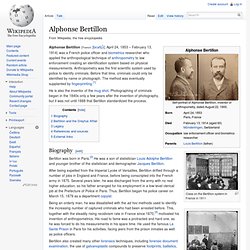
Anthropometry was the first scientific system used by police to identify criminals. Before that time, criminals could only be identified by name or photograph. Locard's exchange principle. In forensic science, Locard's principle holds that the perpetrator of a crime will bring something into the crime scene and leave with something from it, and that both can be used as forensic evidence.
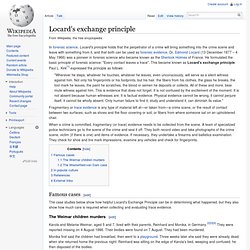
Dr. Edmond Locard (13 December 1877 – 4 May 1966) was a pioneer in forensic science who became known as the Sherlock Holmes of France. He formulated the basic principle of forensic science: "Every contact leaves a trace". This became known as Locard's exchange principle. Paul L. "Wherever he steps, whatever he touches, whatever he leaves, even unconsciously, will serve as a silent witness against him. Fragmentary or trace evidence is any type of material left at—or taken from—a crime scene, or the result of contact between two surfaces, such as shoes and the floor covering or soil, or fibers from where someone sat on an upholstered chair.
When a crime is committed, fragmentary (or trace) evidence needs to be collected from the scene. Famous cases[edit] A Partial Print of the History of Forensic Science. A partial print of the history of forensic science Forensic science is the application of scientific techniques to the evidence in a criminal investigation.
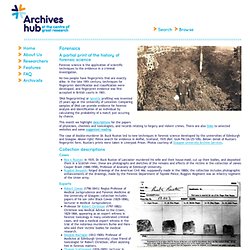
No two people have fingerprints that are exactly alike. In the late 19th century, techniques for fingerprint identification and classification were developed, and fingerprint evidence was first accepted in British courts in 1901. 'DNA fingerprinting' or 'genetic profiling' was invented 25 years ago at the University of Leicester. Comparing samples of DNA can provide evidence for forensic analysis and identification of an individual by calculating the probability of a match just occuring by chance. This month we highlight descriptions for the papers of physicians, chemists and toxicologists, and records relating to forgery and violent crimes. The case of double-murderer Dr. Collection descriptions Cases Rex v. History of Forensics" History of Forensic Science. History of Forensic Science Welcome to the history of forensic science page.
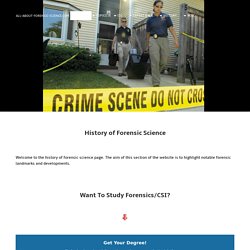
The aim of this section of the website is to highlight notable forensic landmarks and developments. Want To Study Forensics/CSI? The concept of applying 'scientific' principles to legal questions has a long and intriguing history. For example: In 44BC following the assassination of Julius Caesar the attending physician proclaimed that of the 23 wounds found on the body ‘only one’ was fatal.In the 5th century Germanic and Slavic societies were believed to be the first to put down in statute that medical experts should be employed to determine cause of death.In 1247 the first textbook on forensic medicine was published in China which among others things documented the procedures to be followed when investigating a suspicious death.In medieval England pressure from the church halted the practice of hanging women thought to be pregnant.
Forensic Science Timeline. This is a historical timeline of forensic breakthroughs and events dating back to 44 BC to our current year.
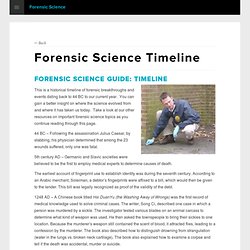
You can gain a better insight on where the science evolved from and where it has taken us today. Take a look at our other resources on important forensic science topics as you continue reading through this page. 44 BC – Following the assassination Julius Caesar, by stabbing, his physician determined that among the 23 wounds suffered, only one was fatal. 5th century AD – Germanic and Slavic societies were believed to be the first to employ medical experts to determine causes of death. The earliest account of fingerprint use to establish identity was during the seventh century. 1248 AD – A Chinese book titled Hsi DuanYu (the Washing Away of Wrongs) was the first record of medical knowledge used to solve criminal cases. 1600s – This century saw the first documented pathology reports. Crimeline * history of forensic sciences * history of criminology * toxicology * fingerprint * dna analysis * autopsy * arsenic * poison. Police Technology - Forensic Science History. Introduction: What is Forensic Science & History?

Polygraph MachinesOther Equipment: Fingerprinting, Police CarsTimeline of Police Technology 1850 - 1960, 1960 - 1996 What is Forensic Science? Forensic science is a scientific method of gathering and examining evidence. Crimes are solved with the use of pathological examinations that gather fingerprints, palm prints, footprints, tooth bite prints, blood, hair and fiber samples. Handwriting and typewriting samples are studied, including all ink, paper, and typography. Timeline020702. A Summarized History of Forensic Science. A Summarized History of Forensic Science!
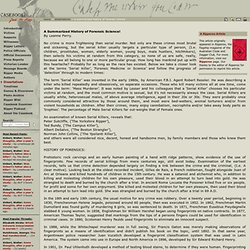
By Leanne Perry. No crime is more frightening than serial murder. Not only are these crimes most brutal and sickening, but the serial killer usually targets a particular type of person, (I.e. children, prostitutes, women, elderly women, young boys, male hustlers, hitchhikers), then selects his victims at random from this category, so none of us are safe, really, because we all belong to one or more particular group. How long has mankind put up with this heartache? Probably for as long as the race has existed. The term ‘Serial Killer’ was invented in the early 1980s, by American F.B.I. Forensic Science Central History of Forensic Science.